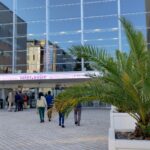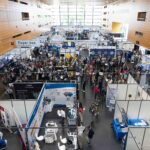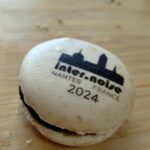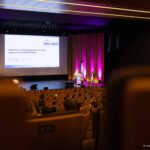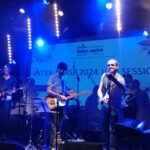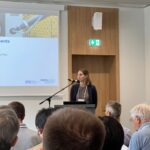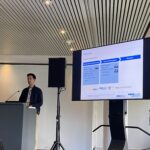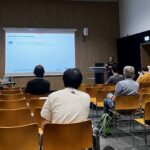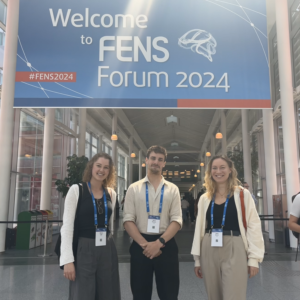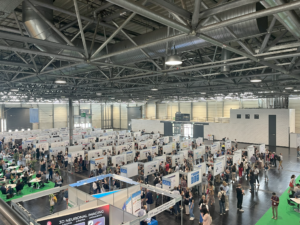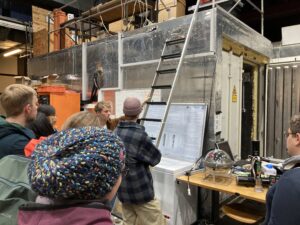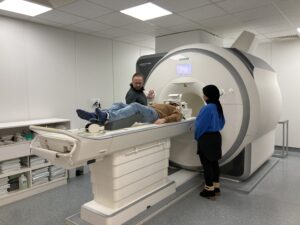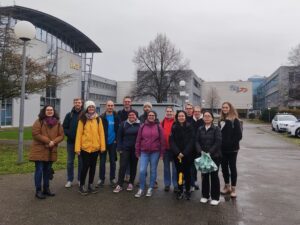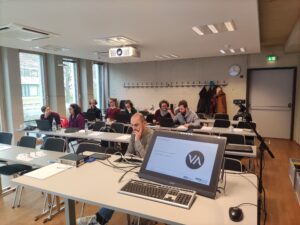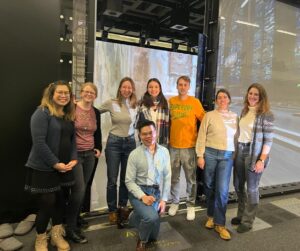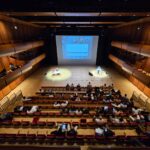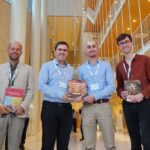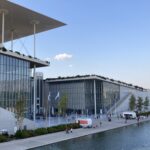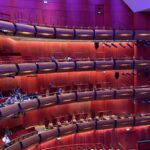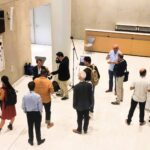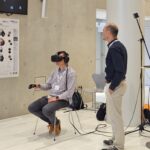Kategorie: ‘IHTA’
World Congress of Audiology 2024 in Paris
Last week, Julia Seitz attended the World Congress of Audiology 2024 in Paris. The conference spanned a variety of topics in audiology, from auditory implants and hearing aids to cognition and noise exposure. On the topic of cognition, Julia Seitz presented her poster „Exploring Listening Effort in Adults: A Study Using an Overlapping Dual-Task Paradigm in Multi-Talker Babble Noise“ at the conference.

Photo by Julia Seitz
Ehrenamtliches Engagement in Fachgesellschaften und Vereinen
Die ehrenamtliche Mitarbeit in Fachgesellschaften und Vereinen im Kontext des wissenschaftlichen Feldes der Akustik ist für die Koordination, den Austausch, die Ausrichtung und die Wahrnehmung des Fachbereichs auch in der Öffentlichkeit von großer Bedeutung.
Auch die wissenschaftlichen Mitarbeiter*innen am IHTA sind bereits in verschiedenen Rollen in Vereinen aktiv. Im August 2024 wurde Lara Stürenburg zum zweiten Mal in den Vorstandsrat der Deutschen Physikalischen Gesellschaft e.V. (DPG) im Bereich Hochschule gewählt. Herzlichen Glückwunsch zu dieser Wahl!
Die DPG ist die größte physikalische Fachgesellschaft der Welt und engagiert sich zu physikalischen Themen, vor allem fördert sie einen Informationsaustausch durch die Organisation von Fachtagungen. Auch die Nachwuchsförderung wird insbesondere durch den Arbeitskreis junge DPG unterstützt, in dem Lara zwischen 2018 und 2020 die Öffentlichkeitsarbeit übernommen hat.
Sowohl Prof. Janina Fels als auch Prof. Michael Vorländer haben bisher ebenfalls zahlreiche Ämter in Vereinen und Gesellschaften mit Akustikbezug wahrgenommen, beispielsweise auch im Vorstand der Gesellschaft der Deutschen Gesellschaft für Akustik e.V. (DEGA), in der derzeit auch IHTAs ehemaliger akademischer Direktor Gottfried Behler Mitglied des Vorstandes ist. Aktuell hat Michael Vorländer die Rolle des Präsidenten der amerikanischen Akustikgesellschaft (ASA) inne während Janina Fels seit 2020 als Fachkollegiatin in der Deutschen Forschungsgemeinschaft (Fach Akustik – Fachkollegium Mechanik und Konstruktiver Maschinenbau) gewählt ist (Wiederwahl in 2023) und darüber hinaus auch als zweite Vorsitzende des technischen Komitees „Psychological and Physiological Acoustics“ in der europäischen Akustikgesellschaft (EAA) aktiv ist.
In der Fachgruppe „junge DEGA“ wurde zudem unser wissenschaftlicher Mitarbeiter Jonas Heck bei der DAGA 2024 in Hannover als Fachgruppenleitung gewählt. Gemeinsam mit der Stellvertreterin Tabea Breitkreutz von der Hochschule Mittweida koordiniert er die Aktivitäten der Fachgruppe, unter anderem die Durchführung des bevorstehenden Herbstworkshops in Leipzig und Mittweida (eine Anmeldung ist hier noch bis zum 1. Oktober 2024 möglich).
Inter-Noise 2024 in Nantes
This year’s Inter-noise conference took place from August 25th to 29th in Nantes, France. More than 1500 delegates participated in this conference and presented interesting research in the field of acoustics and noise. Highlights of the conference included a plenary talk by Arnaud Can and Pierre Aumond (Joint Research Unit in Environmental Acoustics at Gustave Eiffel University, Nantes, France) on advanced characterization of urban sound environments and a keynote lecture about the child perspective on noise exposure and health effects, held by Kerstin Persson Waye from Gothenburg University, Sweden, who is also collaborating with IHTA in the Equal-Life project.
Members of IHTA travelled to the conference and presented the following research papers:
- Chalotorn Möhlmann: Validation measurement of vehicle pass-by models for dynamic urban environments (results of the BaLSaM project)
- Marco Berzborn: Inference of the acoustic properties of transversely isotropic porous materials
- Lara Stürenburg: Loudness and preference judgments for noises of a heat pump (results of the LowNoise project)
- Joao Fatela (Guest researcher from the University of Campania Luigi Vanvitelli, Naples, Italy):
An experimental setup to investigate relevant validation parameters for the auralization of commercial aircraft flyovers in complex urban contexts
Directly after the closing ceremony of the conference, the satellite workshop “Unlocking the Potential of Open Research Software in Acoustics at Inter-Noise 2024” started. This event was organized by Maarten Hornikx and Huiqing Wang, from the Building Acoustics team of Eindhoven University of Technology, and included interesting exchanges and presentation on the development, maintenance, documentation and distrubtion of acoustics-related open-source software. As one of four invited speakers, Lukas Aspöck held a presentation about IHTA’s auralization software Virtual Acoustics. The slides of this presentation are available for download (CC BY-SA 4.0).
Next to insightful overview presentations by Maarten Hornikx and Huiqing Wang, further successful research software was presented: Pyroomacoustics by Eric Bezzam, NoiseModelling by Pierre Aumond and SoundScapy by Andrew Mitchell, along with many examples of challanges and best practices for open research and open-source software development. Many thanks to Maarten and his team for the invitation and the organization of this exciting event.
- Entrance of the InterNoise venue. Photo: Lukas Aspöck
- Exhibition area at Internoise. Photo: Simon Bianchetti.
- Internoise 2024 Macarons. Photo: Lukas Aspöck
- Kerstin Persson Waye at her keynote presentation. Photo: Simon Bianchetti.
- Jam Session @ InterNoise. Photo: Lukas Aspöck
- Lara during her presentation. Photo: Lara Stürenburg.
- Chalotorn during his presentation. Photo: Carolin Schliephake.
- Lukas during the research software workshop. Photo: Enkela Alimadhi
PhD position in the field of audiovisual psychophysics
We (Institute for Hearing Technology and Acoustics (IHTA), RWTH Aachen University, https://www.akustik.rwth-aachen.de) have an open position (100% TV-L E13) in the Research Training Group 2416 – Multi senses, Multi scales.
Within the scope of the Research Training Group 2416 – Multi senses, Multi scales (DFG, https://www.rtg2416.rwth-aachen.de) we focus on the perceptual evaluation and cognitive processing of acoustic and audiovisual stimuli. In this context, listening experiments are designed, implemented, tested, and performed to challenge models of cognition and gain a deeper understanding of cognitive processes. The behavioral results of these experiments are complemented by (electro-)physiological measures, such as the electroencephalogram (EEG) to uncover new relationships between bio signals and behavior.
All details about the position and application can be found here (German language skills required):
We look forward to receiving your application!
Promotionsprüfung Elie Abi Raad
Am 16.07.2024 hat Herr Elie Abi Raad seine Promotionsprüfung zum Thema „Real-time monitoring of ultrasonic metal welding using horn and anvil vibrations and sound measurements“ erfolgreich abgeschlossen.
Das IHTA gratuliert herzlich!
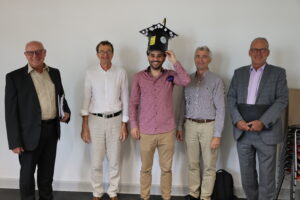
Foto: Christian Dreier
Promotionsstelle im Bereich audiovisuelle virtuelle Realität
Wir (Institute for Hearing Technology and Acoustics (IHTA), RWTH Aachen University) haben eine Stelle (100% TV-L E13) im AUDICTIVE Schwerpunkt Programm (www.spp2236-audictive.de) offen.
Im Rahmen des DFG-Schwerpunktprogramms AUDICTIVE (www.spp2236-audictive.de) suchen wir eine*n Doktorand*in im Bereich Akustik für ein interdisziplinäres Projekt mit Projektpartnern aus der Psychologie und der virtuellen Realität.
Das Ziel dieses Forschungsvorhabens ist es, audiovisuelle Variationen realistischer Hörsituationen (Kommunikationssituationen/Klassenraum) in Virtueller Realität (VR) zu untersuchen und ihre Auswirkungen auf die auditive Leistung/Aufmerksamkeit/Höranstrengung/Hörverstehen etc. der Zuhörer/innen zu untersuchen. Durch die Untersuchung der Effekte verschiedener Merkmale der audiovisuellen VR auf die oben genannten kognitiven Leistungen möchten wir wichtige Erkenntnisse für die Schaffung realistischer und immersiver verbaler sozialer Interaktionen gewinnen und somit zur aktuellen VR-basierten Kognitionsforschung beitragen sowie Empfehlungen für die weitere Forschung geben.
Alle Details zur Stelle und Bewerbung finden Sie hier: https://www.rwth-aachen.de/go/id/kbag/file/V000008052/
Wir freuen uns auf Ihre Bewerbung!
FENS Forum 2024 in Vienna
Last week, our colleague Natálie Brožová, along with her Research Training Group “MultiSenses – MultiScales” colleagues Moritz Nesseler and Melissa Lober, attended the Federation of European Neuroscience Societies (FENS) Forum 2024 in Vienna. The event spanned a broad spectrum of neuroscience topics, from computational approaches to experimental studies, including the neuroscience of multisensory integration.
The forum featured a diverse program with notable keynote lectures from global leaders in the field. Highlights included „Moving Beyond Barriers“ by Professor Viviana Gradinaru, who has pioneered optogenetics and systemic gene delivery to the brain, and „Allostasis as the Brain’s Most Basic Function“ by Professor Lisa Feldman Barrett, which delved into recent discoveries about brain architecture and its corresponding computational affordances.
Additionally, the Nobel laureate Eric Kandel awarded his prize and highlighted the significant contributions of Mackenzie Mathis and Alexander Mathis, known for their work on neural mechanisms of behavior. Their talk demonstrated how both specialized and general neural networks are advancing our understanding of behavior.
This year’s forum welcomed more than 7,000 neuroscientists, creating an incredibly lively atmosphere that fostered new insights and potential collaborations!
- Photo: Natálie Brožová
- Photo: Natálie Brožová
Feierliche Grundsteinlegung des Cube3 – Neubau des Instituts für Hörtechnik und Akustik (IHTA)
Feierliche Grundsteinlegung des Cube3 – unserem Neubau für das Institut für Hörtechnik und Akustik (IHTA) in den auch das Institut für Kommunikationssysteme und das Institut für Theoretische Elektrotechnik einziehen werden.
Heute, am 28. Juni 2024, wurde im festlichen Rahmen der Grundstein für den Neubau des IHTA gelegt.
Im Cube 3 erhält das IHTA neben den Büro- und Meetingräumen einen neuen reflexionsarmen Vollraum, einen reflexionsarmen Halbraum, einen Hallraum, ein Labor für audiovisuelle virtuelle Realität, diverse Hörkabinen und Labore für Praktika, sowie eine mechanische und elektrische Werkstatt.
Ina Brandes, Ministerin für Kultur und Wissenschaft des Landes Nordrhein-Westfalen, Dr. Dirk Günnewig, Staatssekretär im Ministerium der Finanzen des Landes Nordrhein-Westfalen, Univ.-Prof. Ulrich Rüdiger, Rektor der RWTH Aachen University, Ute Willems, Niederlassungsleiterin des BLB NRW in Aachen und Dr. Margrethe Schmeer, Ratsmitglied und Bürgermeisterin der Stadt Aachen, nahmen teil und versenkten dabei eine Zeitkapsel.
Die Zeitkapsel enthält verschiedene Gegenstände, darunter eine Urkunde zur Grundsteinlegung, eine aktuelle Zeitung – das IHTA legte eine Miniatur unseres Kunstkopfes (ein zweiohriges, binaurales Messmikrofon, mit dem man Geräusche, wie der Mensch mit seinen zwei Ohren aufnehmen kann) und eine Miniatur unseres Dodekaeders (ein omnidirektionaler Messlautsprecher für z. B. Messungen der Raumakustik) bei – beides am IHTA entwickelt.
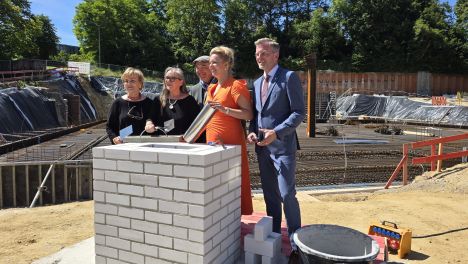
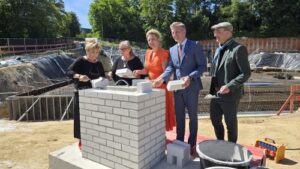
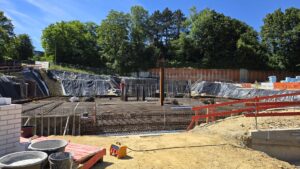
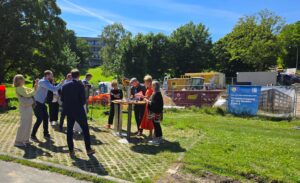
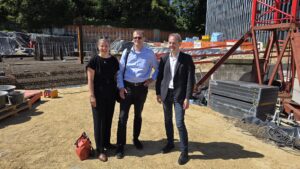
2nd IHTA Retreat
On the 23rd and 24th of May 2024, the scientific staff of IHTA was on a retreat at Fährhaus km734 in Düsseldorf. During these two days, the aim was to foster collaboration and exchange between the researchers. Next to an inspiring presentation on personal strengths and interests by the moderator and career coach Bastian Hughes, we helped each other understand individual challenges in more depth by visiting different world cafés. Further, we learned that most researchers face the same obstacles during their careers. Team spirit was challenged during an evening pub quiz and finding solutions for the identified obstacles in team sessions.
Overall, it was two successful days with a lot of input for each individual and a lot of output for the group at IHTA.
A big thank you to Bastian Hughes, who guided us through the two days with his great moderation!
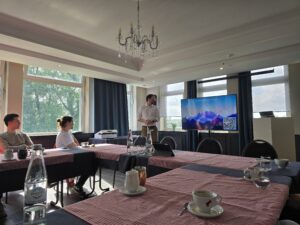
Vortrag von Bastian Hughes
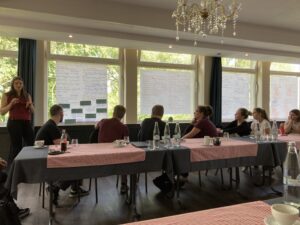
Ergebnisse der World Cafés
Einladung zum Halbzeittreffen des BaLSaM-Projekts am 21.5.
Das Konsortium des Projekts “Braunkohlereviere als attraktive Lebensräume durch Straßengeräuschsimulation auf Basis bestehender Verkehrsdaten zur Minimierung von Lärm”(BaLSaM) lädt zum öffentlichen Halbzeittreffen ein. Es wird am 21.5.2024 von 8:30-13:00 Uhr im Institut für Kraftfahrzeuge der RWTH Aachen University stattfinden (Adresse: Steinbachstraße 7, 52074 Aachen, Deutschland).
Während des Treffens werden die Projektpartner den bisherigen Fortschritt des Projekts zu präsentieren. Darüber hinaus wird das Event die Gelegenheit bieten, Erfahrungen auszutauschen und gemeinsam an zukünftigen Herausforderungen und Fragestellungen zu arbeiten. Neben der Teilnahme vor Ort ist auch eine digitale Teilnahme an der Veranstaltung möglich. Bitte füllen Sie in beiden Fällen das folgende Formular aus, um sich für die Teilnahme zu registrieren.
Anmeldung: https://www.balsam-projekt.de/de/halbzeitevent.html
Agenda:
| 08:30 | Ankommen |
| 09:00 | Begrüßung |
| 09:10 | Projektvorstellung |
| 09:30 | Beschreibung der Schallquelle Fahrzeug |
| 10:00 | AVAS-Geräuschband & Lärmwahrnehmung |
| 10:30 | Kaffeepause |
| 11:00 | Schallausbreitungssimulation |
| 11:30 | Optimierungsstudie |
| 12:00 | Pause für offenen Austausch |
| 12:30 | Abschluss mit Institutsführung |
— English version —
The consortium of the project “Braunkohlereviere als attraktive Lebensräume durch Straßengeräuschsimulation auf Basis bestehender Verkehrsdaten zur Minimierung von Lärm” (BaLSaM) invites you to the public mid-term meeting. It will take place on May 21, 2024 from 8:30-13:00 at the Institute of Automotive Engineering at RWTH Aachen University (address: Steinbachstraße 7, 52074 Aachen, Germany).
The BaLSaM project investigates how traffic noise can be simulated and auralized, aiming to develop concepts to minimize road noise to create more pleasant environments. During the meeting, the project partners will present the progress of the project. In addition, the event will provide an opportunity to exchange experiences and discuss future challenges and research questions. In addition to on-site participation, digital participation in the event is also possible. In both cases, please fill out the following form to register for participation.
Agenda and registration: https://www.balsam-projekt.de/de/halbzeitevent.html
President-Elect of the Acoustical Society of America
In the 2024 Election of the Acoustical Society of America (ASA), Prof. Dr. rer. nat. Michael Vorländer has been elected to be the next president of the ASA. From May 2024, Michael will begin his three-year term of office, in which he will pass through the roles of President-Elect, President and Past President.
The presidency will be the culmination of many years of scientific involvement in the ASA, including being a member of ASA’s executive council, regular participation in ASA meetings, many years of activity as a reviewer and associate editor as well as the publication of numerous scientific articles in the Journal of the ASA (JASA), and also the awarding of the Wallace Clement Sabine Medal in 2018.
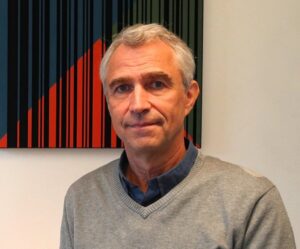
Congratulations Michael, to this prestigious position!
Posterpreis bei der DAGA 2024
Bei der diesjährigen in Hannover stattgefundenen Jahrestagung für Akustik DAGA 2024 erhielt unsere wissenschaftliche Mitarbeiterin Lara Stürenburg den Preis für das beste Poster, ausgewählt von einer Jury aus fachlich versierten Mitgliedern der DEGA. Herzlichen Glückwunsch!
Der dazugehörige Beitrag mit dem Titel Herausforderungen bei Messungen von Lüftungsgeräuschen in einem reflexionsfreien Halbraum ist gemeinsam mit allen anderen Beiträgen der Konferenz im online frei zugänglichen Tagungsband veröffentlicht.
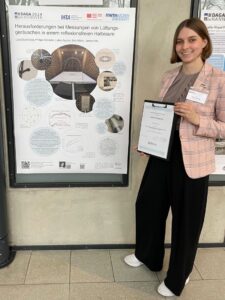
Cognitive neuroscience of auditory and cross-modal perception 2024
Last week, our colleagues Carolin Breuer and Natálie Brožová presented their work at the 5th workshop on Cognitive neuroscience of auditory and cross-modal perception in Kosice, Slovakia. The workshop was focused on neural processes of auditory, visual, and cross-modal perception with a special focus on spatial audio virtualization and gamification for hearing assessment and enhancement. Featuring 16 invited talks as well as contributed posters and presentations, the workshop allowed for a very familiar atmosphere that encouraged exchanges among attendees. These participants came from diverse fields such as acoustics, neuroscience, biology, and psychology, to name just a few.
Natálie Brožová presented her recent study on “Investigating the Neural Basis of Audiovisual Cross-modal Correspondences and Their Influence on Perceptual Decision-Making” which is part of the interdisciplinary Research Training Group “MultiSenses – MultiScales”.
Carolin Breuer presented a poster investigating visual priming on auditory selective attention in Virtual Reality which is an extension of a previous study presented at DAGA 2023 and was conducted as part of the ECoClass-VR project related to the priority program AUDICTIVE.
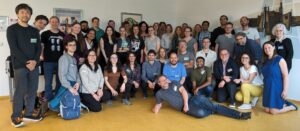
Group Picture of KogNeuro Workshop 2024
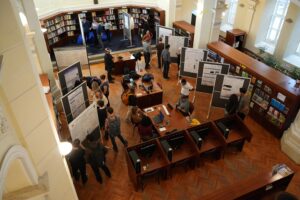
Poster Session during KogNeuro Wkroshop 2024
Promotionsprüfung Thiago Lobato
Am 12.04.2024 hat Herr Thiago Lobato seine Promotionsprüfung zum Thema „Improving sound source localization and characterization with machine learning techniques“ erfolgreich abgeschlossen.
Das IHTA gratuliert herzlich!
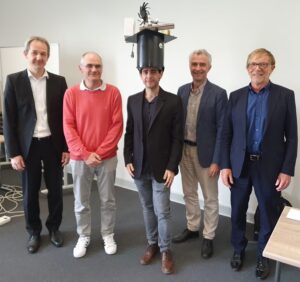
Bild: Julian Becker/Roland Sottek
IHTA goes DAGA 2024
Again, IHTA is joining DAGA in Hannover with interesting contributions from March, 19th, to March, 21th, 2024. We are delighted to invite to our presentations and posters. In total, IHTA members will be represented with 19 contributions (15 presentations and 4 posters):
| Dienstag, 19.03.2024 | |||
| Thomas Deutsch, Luigi Falanga, Iring Koch, Janina Fels | Sound Localization Performance with and without Simulated Hearing Loss: Comparison of Different Spatial Audio Reproduction Methods | 13:40 | Raum 7/9 |
| Simon Kersten, Franck Sgard, Michael Vorländer | Impact of the Ear Canal Motion on the Occlusion Effect for Bone-Conducted Stimulation | 14:20 | Raum 7/9 |
| Christian Dreier, Michael Vorländer | Air traffic auralization: Modeling and synthesis of drones | 15:00 | Blauer Saal |
| Philipp Schäfer, Pascal Palenda, Lukas Aspöck, Michael Vorländer | Plug-and-play tutorials for the auralization of complex scenarios using an open-source simulation framework (Poster) | 15:20 | Poster-Forum |
| Hark Braren, Janina Fels | Wie gut können Kinder Schallquellen lokalisieren? (Poster) | 15:20 | Glasgang, Posterbereich D |
| Lukas J. Vollmer, Frederike Rust, Janina Fels | Intuitive Pitch-to-Digit Associations Do Not Support Verbal Short-Term Memory | 16:00 | Roter Saal |
| Melchior Käppel, Marco Berzborn, Michael Vorländer | Untersuchungen zu Ambisonics-Decodern für irreguläre Lautsprecherarrays im Nahfeld | 16:00 | Blauer Saal |
| Natálie Brožová, Lukas Vollmer, Christoph Kayser, Björn Kampa, Janina Fels | Audiovisual Cross-modal Correspondences and Their Influence on Perceptual Decision Making | 16:20 | Roter Saal |
| Anne Heimes und Michael Vorländer | A new scattering metric for auralization in urban environments | 17:20 | Blauer Saal |
| Julia Seitz, Karin Loh, Janina Fels | Assessing Listening Effort in Primary School Children: A Dual-Task Approach | 17:40 | Raum 7/9 |
| Niklas Mika, Pascal Palenda, Jonas Heck, Michael Vorländer | Incorporating complex surface impedance into auralization filters based on Image Sources | 17:40 | Blauer Saal |
| Jonas Heck, Josep Llorca-Bofí, Christian Dreier, Michael Vorländer | Does ambient sound enhance outdoor auralization? | 18:00 | Blauer Saal |
| Mittwoch, 20.03.2024 | |||
| Chalotorn Möhlmann, Pascal Palenda, Michael Vorländer, Janina Fels | Comparing Simulated and Measured Urban Traffic Noise | 09:00 | Blauer Saal |
| Pascal Palenda, Philipp Schäfer, Michael Vorländer | Open-source exchange format for sound paths in interactive simulation | 17:00 | Runder Saal |
| Donnerstag, 21.03.2024 | |||
| Chinthusa Mohanathasan, Jonathan Ehret, Andrea Bönsch, Cosima A. Ermert, Janina Fels, Torsten W. Kuhlen, Sabine J. Schlittmeier | The Role of Talker Visibility on Memory and Listening Effort during Conversations | 08:40 | FMS B |
| Carolin Breuer, Robert Schmitt, Larissa Leist, Stephan Fremerey, Alexander Raake, Maria Klatte, Janina Fels | Exploring the Impact of Realistic Classroom Noise on Auditory Selective Attention | 10:20 | FMS B |
| Lara Stürenburg, Philipp Ostmann, Lukas Aspöck, Dirk Müller und Janina Fels | Herausforderungen bei Messungen von Lüftungsgeräuschen in einem reflexionsfreien Halbraum (Poster) | 11:00 | Glasgang, Posterbereich D |
| Lukas Aspöck, Melchior Käppel, Carolin Breuer, Jonathan Ehret, Andrea Bönsch, Isabel S. Schiller, Sabine J. Schlittmeier, Torsten W. Kuhlen, Janina Fels | Real-Time Auralization for a VR-based Investigation of Background Sounds in a Classroom Scenario (Poster) | 11:00 | Glasgang, Posterbereich A |
| Alexander Raake, Stephan Fremerey, Carolin Breuer, Larissa Leist, Maria Klatte, Janina Fels | Towards using Audiovisual Scene Analysis to Evaluate Cognitive Performance in Classroom Scenarios | 15:20 | FMS B |
An overview of all contributions and updated information can be found in the DAGA 2024 App.
We are looking forward to seeing you at DAGA 2024!
Open PhD positions at the Institute for Hearing Technology and Acoustics at RWTH Aachen University
Application deadline extended until March 27, 2024!
We are hiring!
Are you looking for a PhD position in acoustics?
The Institute for Hearing Technology and Acoustics at RWTH Aachen University focuses on the physical and technical aspects of sound as well as the human perception and processing of sound.
We have three open positions:
1. as part of the DFG priority program AUDICTIVE we are looking for a doctoral candidate in the field of acoustics for an interdisciplinary project with project partners from psychology and virtual reality:
Job ID V000007166: Research assistant (f/m/d) – PhD position in the field of audiovisual virtual reality
2. as part of a research project funded by the Federal Aeronautical Research Program, we are looking for a PhD student in the field of acoustics to investigate the sound propagation and perception of different flight routes and strategies of Unmanned Aircraft Systems (UAS):
Job ID V000007199: Research assistant (f/m/d) – PhD position in the field of sound propagation and perception of unmanned aircraft systems (UAS)
3. within the framework of the Collaborative Research Center „Hearing Acoustics“ (SFB 1330, HAPPAA, https://uol.de/en/sfb-1330-hearing-acoustics) funded by the German Research Foundation, we are looking for a doctoral candidate in the field of acoustics to research the perception of one’s own voice when using hearing aids and assistive listening devices in communication situations:
Job ID V000007200: Research assistant (f/m/d) – PhD position in the field of perception of one’s own voice when using hearing aids and assistive listening devices in communication situations
Please apply indicating the job ID and a detailed application (see the links above for application details) at jobs@akustik.rwth-aachen.de by March 27, 2024.
We look forward to receiving your application!
junge DEGA Herbstworkshop 2023 in Aachen
From 17th to 19th November 2023, the “junge DEGA Herbstworkshop” (autumn workshop) took place in Aachen. Junge DEGA is a section of the German Acoustical Society (DEGA) and partner of the Young Acousticians Network (YAN) of the European Acoustics Association (EAA). Its mission is to connect students, PhDs and young professionals in the domain of acoustics. The group organizes special sessions and panel discussions during the Annual German Conference on Acoustics (DAGA), providing information on research opportunities and job entry. Furthermore, junge DEGA offers a mentoring program with active participation from industry and academia.
The workshop started on Friday afternoon with a visit of HEAD Acoustics GmbH in Kohlscheid, where the participants got insights into the company’s research and development activities and experienced some hands-on demonstrations of new products. After this first visit, three RWTH spin-offs – FEV, KLANG, elevear – reported on their experiences in business practice and illustrated different career paths in the field of acoustics. The first day concluded with a meeting of the group resuming the year’s activities and discussing the plans for the upcoming conference DAGA 2024.
On Saturday, the participants visited four laboratories at RWTH Aachen University. The day started with a welcoming tour at the Institute for Hearing Technology and Acoustics (IHTA) with demonstrations of the room acoustics simulation software RAVEN, experiments for audio-visual perception studies and the SCaLAr loudspeaker array. The Institute for Automotive Engineering (ika) opened the doors to their semi-anechoic climate chamber and to a broad range of tire test rigs, which are used to determine the dynamic load during tire-road contact under the influence of different road surfaces. The Experimental Behavioral Psychobiology group & Brain Imaging Facility at RWTH University hospital presented research in which specific acoustic stimuli are used during magnetic resonance imaging to better understand the auditory processing with schizophrenia. Finally, the III. Physics Institute B presented its research on a sonar- and radar-equipped melting probe which aims to penetrate the ice shield and explore the subglacial ocean of the Jovian moon Europa (TRIPLE). Another project focused on the use of acoustic measurements to calibrate the neutrino observatory IceCube.
The weekend concluded with a hands-on workshop on binaural synthesis and virtual acoustics applications (see virtualacoustics.org) at IHTA.
Thanks to all participants and supporters!
- III. Physics Institute B, Photo: Jonas Heck
- Brain Imaging Facility at RWTH University hospital, Photo: Jonas Heck
- Institute for Automotive Engineering (ika), Photo: Olaf Uszynski
- Hands-on workshop at IHTA, Photo: Pascal Palenda
Equal-Life Symposium in Aachen
On December 14th and 15th seven PhDs and one Postdoc from the Equal Life project met for a symposium in Aachen. The participants provided a wide perspective on their PhD projects within Equal-Life. The two days were filled with good dialougue on challenges yet to overcome and achievements reached in each project part. Questions about research aims, methods, and results were answered and experiences were shared. Additionally, the exposome concept that Equal-Life is based on was subject of dicusscion alongside methods for responsible research and innovation. Everyone experienced a demo in the AixCave to learn about acoustic and virtual reality research. And of course, Aachen’s Christmas market was visited in the evening.
- Foto: IHTA
International Conference on Auditorium Acoustics 2023 in Athens
From September 28th to 30th, the Institute of Acoustics has held the 11th International Conference on Auditorium Acoustics at the Stavros Niarchos Foundation Cultural Center (SNFCC) in Athens, Greece. Jonas Heck and Josep Llorca-Bofí as well as our alumnus Ingo Witew presented their research in the field of concert halls and room acoustics:
- Jonas Heck, Josep Llorca-Bofí and Michael Vorländer: Concert Halls in Virtual Reality – From Audio-visual Perception to a Common Vocabulary
- Ingo Witew and Michael Vorländer: Measurements in room acoustics – How good are we at it?
On the first conference day, Jonas Heck and Josep Llorca-Bofí organized a round table to discuss the importance of descriptive vocabulary which can be used to depict the perception in concert halls. The poster „Concert Halls in Virtual Reality – From Audio-visual Perception to a Common Vocabulary“ was accompanied by a demonstration of a recent experiment in virtual reality. It was very well received by the delegates who selected it for the first poster prize.
- Small auditorium, Stavros Niarchos Foundation Cultural Center (SNFCC), Foto: Josep Llorca-Bofí
- Poster award recipients, Foto: Sergio de las Heras
- Stavros Niarchos Foundation Cultural Center (SNFCC), Foto: Jonas Heck
- Big auditorium, Stavros Niarchos Foundation Cultural Center (SNFCC), Foto: Jonas Heck
- Demonstration of experiments in virtual reality, Foto: Sergio de las Heras
- Demonstration of experiments in virtual reality, Background: Poster, Foto: Josep Llorca-Bofí
DAGA 2024 Travel Grants
Die Gesellschaft für Technische Akustik (GfTA e.V.) möchte Studierende des IHTAs unterstützen an der kommenden Jahrestagung für Akustik (DAGA 2024) teilzunehmen. Diese findet vom 18. bis zum 21. März 2024 in Hannover statt und bietet eine sehr spannende Möglichkeit, erste Erfahrungen bei wissenschaftlichen Konferenzen zu sammeln.

Die GfTA fördert in diesem Jahr zwei Studierende mit einen Reisezuschuss (Travel grant) in Höhe von jeweils 250€. Kandidat*innen müssen keinen wissenschaftlichen Beitrag bei der Konferenz einreichen, sollten aber zuvor noch keine DAGA-Konferenz besucht haben und an mind. einer Lehrveranstaltung am IHTA teilgenommen oder eine Abschlussarbeit angefertigt haben / aktuell anfertigen.
Um Dich für den Travel grant zu bewerben, schreibe eine Email an Lukas Aspöck und erkläre in ein oder zwei Sätzen, warum Du motiviert bist an einer Akustik-Konferenz teilzunehmen. Die Deadline für Bewerbungen ist der 14.12.2023, die Bekanntgabe findet bei der IHTA-Weihnachtsfeier am 19.12.2023 statt.


